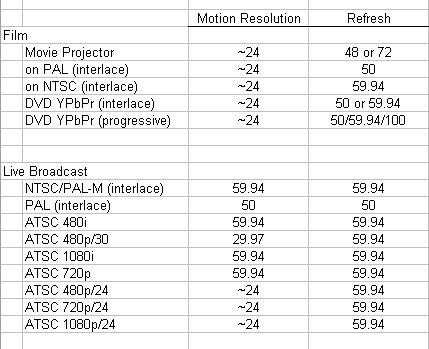...what would be its resolution in pixels/horizontal lines..? I guess it is way higher than any current video standard. Will eventually display/video technology be able to reproduce the "real thing",i.e., video footage the same resolution as that recorded by the human eye? What would it take to get there and how far are we from achieving it?
(not sure where to post this, so give it a try here).
+ Reply to Thread
Results 1 to 6 of 6
-
-
It is more than just a matter of resolution. There is an enormous amount of processing done by the brain of the images we recieve. It filters out fluctuations and changes to lighting and colour, or allows for focussing on parts of an image in a way that cameras still cannot do, or cannot do as effectively. An Australian reseacher has been working on mimicing the way a fly's eyes percieve and filter light changes and detail perception, and has developed ways to enhance footage better than ever before. Apparently US intellegence and local law enforcement are very interested.
as far as mimicing the human visual system, I would suggest current HD is probably about 10% of the way there as far as percieved resolution is concerned, and about 2% for adaptability to environment.Read my blog here.
-
I would imagin that we have the technology already just not the processing power? Refreshrate would be the hard thing to acheive I would imagin, the eye processing movement so well.
As for colour, I beleive we have already exceeded what the eye can interperate in "gradients" of colour. As for lines/pixels, I think that the brain interpolates alot, based on how they orignally designed tv tubes ( skipping lines because you never notice them anyway)
my guess
eye= prgressive scan (interpolated) saves processing power, limited colour gradients AND if you mesure your peripheral, the highest you can see, lowest, fare left and right. then film it and crop to match it will give you your pixel dimention?? -
The human eye has several limitations which make movies and TV possible at lower bandwidth. Most of this was well understood by the 1930's and was incorporated into the motion picture and TV system design.
1. The eye-brain sees a limited color spectrum and resolves detail mostly in green-yellow and less in blue-purple-red.
Video consequence
This is the why TV can use Y, R-Y and B-Y components with bandwidth reduction in R-Y and B-Y.
2. The eye-brain is attracted to small motion areas in an otherwise stationary scene but doesn't resolve as much spatial detail in the moving object itself.
Video consequence
This means detail can be reduced in moving objects with nobody noticing (e.g. single field). It also means noise should be reduced in more stationary parts of the image. The eye wants detail in the low motion areas and is distracted by noise.
3. The eye-brain blends sampled motion (~24-90 samples per second) into what seems like continuous motion. Lower range sample rates 24-30 can be used if frames are repeated to 48-90Hz.
Video consequence
Movie houses can use 24fps film by repeating frames 2x to 48Hz. PAL TV repeats to 50Hz. NTSC TV to 59.94Hz.
Film still looks jerky to most people so interlace TV originates with 50 or 59.94 Hz. motion and field refresh. Progressive video has smoothest motion at 50-59.94Hz. with 50-90+Hz. refresh. That is why 720p/59.94 looks best for sports. -
I'd say 75-100Hz is the sweet spot for motion (which is why good computer monitors get up to that level now).
Plus the fact that the eye constantly flits around assessing the lines and edges of things, changing focus depending on what it perceives as important at that instant.
And then there's the stereoscopic angle... 8)
Scott -
Yes, the eye sees in edges and shapes for moving objects but less internal detail.Originally Posted by Cornucopia
Refresh is best at 75-100Hz but object motion can be lower and still appear continuous.
This approximately how it works for TV.

High end PAL progressive TV sets are now using 100Hz. There is talk of 23.976x3 = 71.93 Hz for NTSC markets. Currently 23.976 alternates 2x 3x to get to 59.94 Hz.
PS: Not so stupid 720p HDTV trick - ABC or FOX could transmit 2 simultaneous 720p/24 movies plus one 480i/29.97 program in the same bandwidth as one 720p/59.94 fps program. The ATSC HDTV tuner is required to do the 3:2 frame repeat to 59.94 fps internally.
Similar Threads
-
A video camera with the quality of an eye
By Northern in forum Newbie / General discussionsReplies: 13Last Post: 17th Oct 2010, 13:40 -
SD Video Camera Vs. HD Movie Mode on Digital Still Camera.
By CP/M User in forum Newbie / General discussionsReplies: 20Last Post: 20th Nov 2009, 15:57 -
Keep an Eye on Video Monkey, VisualHub's replacement.
By terryj in forum MacReplies: 3Last Post: 30th Jul 2009, 00:16 -
Never under estimate the power of human stupidity. 4th of July Fun!
By freebird73717 in forum Off topicReplies: 1Last Post: 7th Jul 2009, 17:18 -
How do I rename VTS_01_1 to something human readable?
By CaptC in forum DVD RippingReplies: 3Last Post: 12th Dec 2007, 06:04




 Quote
Quote